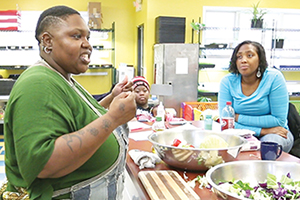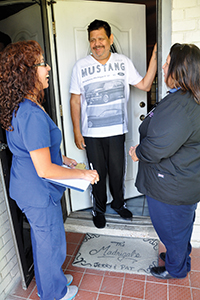By JULIE MINDA For most cancers, African Americans have the highest death rate and shortest survival of any other group in the U.S. They are 1.4 times as likely as white people to have high blood pressure. And twice as likely to have diabetes, according to statistics compiled by the Aetna insurance company.

Through a partnership with Cincinnati's Mercy Health, Sophia Buggs, at left, teaches cooking classes in the health system's Fresh Start and Resource Mothers programs — two programs aimed at attacking health disparities. Buggs owns and runs an urban farm called Lady Buggs Farm in Youngstown, Ohio.
A national collaborative that includes CHA and the American Hospital Association has called for health care providers to get to the root of disparities like these, and to put in place measures to address the problems. The National Call to Action to Eliminate Health Care Disparities is challenging U.S. hospitals to sign a pledge to address three aspects of health inequity with measurable action within a year of signing. The three areas have to do with collecting and using socioeconomic data on race, ethnicity, language preference and income to identify care gaps; with increasing cultural competency training of staff and with increasing diversity in leadership and governance.
Hundreds of U.S. hospitals and health systems — dozens of them Catholic — have signed the collaborative's "Pledge to Act to Eliminate Health Care Disparities."
Larry James is vice president and chief diversity officer of Mercy Health of Cincinnati, which signed the pledge in September. He said of the nation's slow momentum on equity of care, "My opinion — and there is consensus around the industry — is that the biggest barrier to success and progress so far has had to do with the cultural perception that while this (disparity) work is important … it's supplemental and an appendix."
Addressing inequity "needs to be an integral part of how we do what we do, or it will always be what we do after we finish everything else."
Gaining traction
U.S. hospitals have made some progress in recent years when it comes to the three goals set out in the National Call to Action, according to research by the Institute for Diversity in Health Management and the Health Research and Educational Trust in partnership with AHA. The 2013 study said a great deal of work had yet to be done.
The coalition behind the National Call to Action said most hospitals are not analyzing health outcome data to determine which subsets of the community are struggling, and with what conditions — information that would alert them to inequities and enable them to target interventions. Mercy's James said a disproportionate percentage of minority people live in poverty, a status that correlates with poor health status and disparities in health care access, treatment and outcomes.
Dougal Hewitt, chief officer for mission and external affairs for Chicago's Presence Health, which signed the pledge in June, said, "Only when we can see the data can we move beyond the anecdotal. Part of the reason it's been hard to address (disparities) is because we as health care providers often think of ourselves as always seeking to do good. It's hard for us to recognize and acknowledge that some in our communities are not getting the same care as others."
Ernie Sadau is chief executive of Irving, Texas-based CHRISTUS Health, which signed the pledge in July. He said that providing equitable care has been a top priority in concept for ministry organizations since their founding — "because it is part of who we are."
However, he said, efforts fell short despite good intentions. "We didn't know what we didn't know. We weren't collecting data."

Jerry Madrigal lost a toe to diabetes, but he got his disease and weight under control with help from a diabetic support program that CHRISTUS Spohn Health System created to address health disparities in Corpus Christi, Texas. Nurse Melissa Johnson, at left, and community health worker Linda Garcia, both part of the multidisciplinary diabetes team, visit Madrigal at home.
With 34 hospitals and additional facilities in seven U.S. states and two other countries, CHRISTUS' service area is very diverse, said Sadau. For more than a year, the system has been collecting patient demographic data in a standardized way and can pull it by primary diagnosis, patient satisfaction score, readmission rate and other very useful splits, according to Marcos Pesquera, CHRISTUS vice president of health equity, diversity and inclusion. CHRISTUS sites also collect data on income, educational status and zip code and have information on patients' payer source and can use that socioeconomic information in data analysis. Pesquera now is examining outcome measures by race, ethnicity and other factors for each CHRISTUS region, and sharing his analysis with leaders in each region, to help them determine which populations are experiencing the greatest disparities, so they can develop programming to address the gaps.
Both Sadau and Pesquera said the data is informing the system's top priority work, including in population health management, community benefit and insurance enrollment.
"We're more aware now," Sadau said. "And now with the Affordable Care Act criteria, with a focus on population health and taking on responsibility for health and wellness, and with a focus on the health of the entire community — now there are more incentives" to identify and address health disparities.
Hewitt said the smart use of data is enabling Presence, which operates 11 hospitals in Illinois and Indiana, to look at population health in a more expansive way. "We have already seen that disparity is not just around race, there can be disparity related to age, for example, and the disparities may not be what one might expect," he said. "For instance, there are teens — young, white men — in central Illinois with increased rates of suicide, and this is a disparity to address."
The equity pledge also identifies disability status, veteran status, sexual orientation and gender as potentially relevant categories in assessing health care disparities.
Systematic approach
The executives who spoke to Catholic Health World said that prior to signing the pledge, their organizations already had made significant progress in the areas set out by the National Call to Action. All had made extensive changes to their facilities' data systems, to standardize how they collect patient demographic data; and all were beginning to use that data to pinpoint health care disparities and target programs accordingly. All had cultural competency training and efforts underway to recruit or advance more minority associates into leadership roles.
The executives said the pledge is giving these efforts a boost.
Dr. Laura Warner is medical director of a group of community-based family clinics for Centura Health of Englewood, Colo., a 17-hospital system that signed the pledge in December. She said the pledge directives will "organize our efforts and create more of a structure" to work already underway. The organization's senior executive council is reviewing a health equity plan to standardize the way Centura sites use demographic data to identify and address disparities in care. Warner said it's too early to know what will surface under data analysis, but she suspects the system — with sites in Colorado and Kansas — may find people not fluent in English have difficulty accessing care.
Mercy uses data to track metrics related to preventable harm, readmissions, colorectal and breast cancer screenings, blood pressure and hypertension, pneumococcal vaccinations and diabetes care across its 23 hospitals and other facilities in Ohio and Kentucky. It also runs a health composite metric using the data on the screenings, blood pressure and vaccinations. Analysts comb the data to determine which demographic groups are most vulnerable in each area of study. When the experts identify cause for concern for a specific group in a specific geography, the local market develops tailored programs to address those issues. For example, when data analysis revealed that minority populations in neighborhoods of Youngstown, Lorain and Lima in Ohio had high rates of diabetes, the local markets developed healthy eating programs for members of those communities.
Magnifying glass
Sadau said signing the pledge affirmed CHRISTUS' path, and he believes the pledge will have an important impact in the health care field generally. "Care equity is a national issue that is important to everyone. Signing the pledge creates accountability. The data puts a magnifying glass on organizations."
Pledge signatories are not required to publicly report their progress in tackling disparities, but many choose to report their achievements to AHA, according to Hewitt of Presence Health.
Mercy's James said with minority populations collectively moving toward majority status, there is a business imperative to meet those populations' needs. "The bottom line is there is nothing more important than this because our markets are demanding this."
| Benchmarking health care equity The study "Diversity and Disparities: A Benchmark Study of U.S. Hospitals in 2013" says: - Upwards of 94 percent of hospitals collect patient data on race, ethnicity and language preference. Only 22 percent have used that data to identify gaps in treatment and/or outcomes by demographic.
- While 86 percent of hospitals educate all clinical staff during orientation on culture and language topics related to patient care, 64.5 percent mandate employees attend diversity training.
- About 31 percent of patients nationally are minorities, but fewer than 17 percent of hospital leaders are minorities.
The Institute for Diversity in Health Management, the Health Research and Educational Trust and the American Hospital Association partnered to conduct the study. The group has just completed its most recent survey. It will be released later this year. |
Copyright © 2016 by the Catholic Health Association
of the United States
For reprint permission, contact Betty Crosby or call (314) 253-3477.